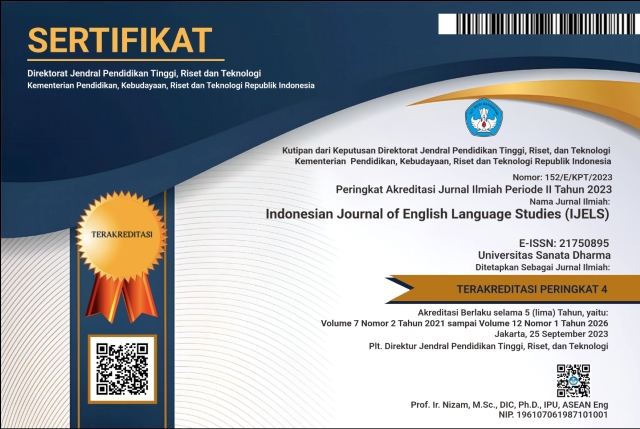Types and Frequencies of Written Corrective Feedbacks in Adult ESL Classroom
(1) Sanata Dharma
(*) Corresponding Author
Abstract
Feedbacks have been seen as an effective way to help language learners acquire second language competence. This study aims to find out how the written corrective feedback (CF) has been used in the adult ESL classroom. In this study, the data were generated through the learner’s writing. Then the data were put into direct, coded and uncoded type of the written corrective feedback. In addition, those types of feedback were categorized into content and form category to find the scope of the written corrective feedback. As the result, the direct written corrective feedback was mostly used by the teachers. Interestingly, the teachers only used the uncoded written corrective feedback when it refers to the content of the writing. Besides, the dynamic corrective feedbacks that occur several times can be a proof that the teachers not only focus on the form the writing but also the content.
Keywords
Full Text:
PDFReferences
Basiron, H. B. (2008). Corrective feedback in dialogue-based computer-based language learning. The New Zealand Computer Science Research Student Conference, (pp. 192-194). Christchurch.
Bitchener, J. (2012). Written corrective feedback for l2 development: current knowledge and future research. (D. Ferris, Ed.) TESOL Quarterly, 4, 855-860. Retrieved from http://www.jstor.org/stable/43267894
Brown, D. (2012, December). The written corrective feedback debate: next steps for classroom teachers and practitioners. TESOL Quarterly, 861-867. Retrieved from http://www.jstor.org/stable/43267895
Ellis, R. (2008). The study of second language acquisition. New York: Oxford University Press.
Ferris, D. (2010). Second language writing research and written corrective feedback in SLA: Intersections and practical applications. Studies in Second Language Acquisition, 181- 201.
Hartshorn, K. J., Evans, N. W., Merill, P. F., Sudweeks, R. R., Strong-Krause, D., & Anderson, N. J. (2010). Effects of dynamic corrective feedback on ESL writing accuracy. TESOL Quarterly, 44, 84-109.
Retrieved 30-03-2017, from http://www.jstor.org/stable/27785071
Hattie, J., & Timperley, H. (2007, March). The power of feedback. Review of Educational Research, 81-112. Retrieved from http://www.jstor.org/stable/4624888
Hyland, F. (1998). The impact of teacher written feedback on individual writers. Journal of Second Language Writing, 255-286.
Hyland, K., & Hyland, F. (2006). Context and issues in feedback on L2 writing: An introduction. In K. Hyland, & F. Hyland, Feedback in second language writing (pp. 1-19). Cambridge: Cambridge Univesity Press.
Kim, Y., & Kim, J. (2005). Teaching Korean university writing class: Balancing the process and the genre approach. The Asian EFL Journal, 69-90.
Lyster, R., & Ranta, L. (1997). Corrective feedback and learner uptake: Negotiation of form in communicative classrooms. Studies in Second Language Acquisition, 37-66.
Mi-mi, L. (2009). Adopting varied feedback modes in the EFL writing class. US-China Foreign Language, 60-63.
Panova, I., & Lyster, R. (2002). Patterns of corrective feedback and uptake in an adult ESL classroom. TESOL Quarterly, 573-595.
Sheen, Y. (2007). The effect of focused written corrective feedback and languange aptitude on ESL learners' acquisition of articles. TESOL Quarterly, 255-283.
Suzuki, M. (2003). Corrective feedback and learner uptake in adult ESL. Columbia University Working Papers in TESOL & Applied Linguistics, 1-21.
Tangmpermpoon, T. (2008). Integrated approaches to improve students writing skill for English major students. ABAC Journal, 1-9.
Tavakoli, H. (2012). A dictionary of language acquisition: A comprehensive overview of key terms in first and second language acquisition. Tehran: Rahnama Press.
Van-Dijk, D., & Kluger, A. (2000). Positive (negative) feedback: encouragement or discouragement?. 15th annual convention of the Society for Industrial and Organizational Psychology. New Orleans, LA.
DOI: https://doi.org/10.24071/ijels.v3i2.1065
Refbacks
- There are currently no refbacks.

This work is licensed under a Creative Commons Attribution-ShareAlike 4.0 International License.
IJELS Journal Sinta 4 Certificate (S4 = Level 4)
We would like to inform you that Indonesian Journal of English Language Studies (IJELS) has been nationally accredited Sinta 4 by the Ministry of Education, Culture, Research and Technology of the Republic of Indonesia based on the decree No. Surat Keputusan 152/E/KPT/2023. Validity for 5 years: Vol 7 No 2, 2021 till Vol 12 No 1, 2026

This work is licensed under CC BY-SA.
Creative Commons Attribution-ShareAlike 4.0 International License
IJELS e-ISSN 2715-0895; IJELS p-ISSN 2442-790X
Indonesian Journal of English Language Studies (IJELS) is published twice a year, namely in March and September, by the English Language Studies (ELS) of the Graduate Program of Sanata Dharma University, Yogyakarta, Indonesia.


 IJELS p-ISSN:
IJELS p-ISSN: 









